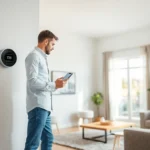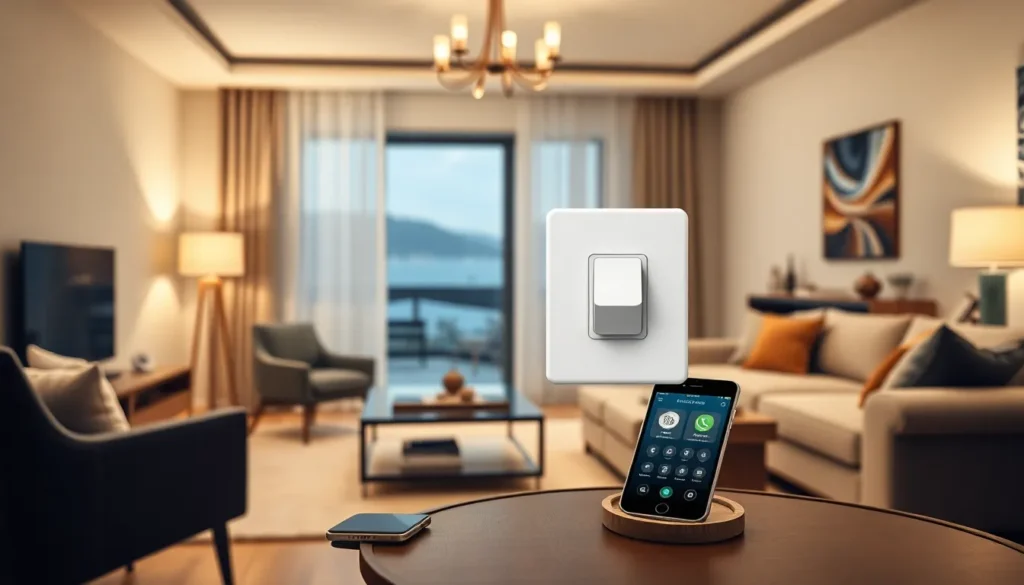Imagine walking into your home and having everything just the way you like it—lights dimmed, temperature perfect, and your favorite tunes playing. With app-based home control, this dream isn’t just a fantasy; it’s a reality. Gone are the days of fumbling for remotes or getting up from the couch to adjust the thermostat. Now, a simple tap on your smartphone can transform your living space into a smart oasis.
Overview of App Based Home Control
App-based home control streamlines the management of various household devices. Homeowners enjoy the convenience of controlling lighting, temperature, and entertainment systems directly from their smartphones. With this technology, tasks such as adjusting the thermostat or dimming lights occur with a single tap.
Users experience increased energy efficiency through automated settings, enabling them to schedule devices based on daily routines. For instance, a homeowner might program lights to turn on at sunset. Security features also enhance home safety, allowing real-time monitoring of security cameras from anywhere.
Integration with voice assistants enhances the user experience further. Homeowners can issue commands hands-free, creating a seamless interaction with their smart devices. Many platforms offer compatibility with numerous devices from various manufacturers.
App-based solutions often provide customization options. Users can create scenes for specific activities, like movie nights or dinner parties, adjusting multiple devices simultaneously. This flexibility significantly enhances the lifestyle for tech-savvy individuals.
Data collected from smart devices offers valuable insights into usage patterns. Homeowners can monitor energy consumption through their apps, allowing for more informed decisions. Simple analytics can lead to reduced energy bills over time.
Overall, app-based home control represents a significant advancement in home automation. The ability to manage one’s environment remotely not only provides convenience but also fosters a smarter, more efficient home ecosystem.
Key Features of App Based Home Control

App-based home control offers various features that enhance the user experience and optimize household management. With intuitive designs, streamlined functionality empowers homeowners to enjoy seamless automation.
User Interface Design
User interface design plays a crucial role in app-based home control. Simple navigation enhances usability, allowing users to access all functions effortlessly. Icons and graphics often provide a visual guide, making setup straightforward. Feedback prompts can guide users through adjustments, improving interaction. In addition, customization options enable individuals to personalize layouts according to preferences. Intuitive controls significantly contribute to user satisfaction, ensuring everyone can operate their home environment easily.
Compatibility with Smart Devices
Compatibility with smart devices is essential for comprehensive home automation. Most apps seamlessly connect to a variety of devices, including thermostats, lights, and security cameras. Integration across platforms allows users to control multiple devices from one app. Interoperability ensures that devices from different manufacturers work together effectively. Moreover, frequent updates expand compatibility, accommodating new devices as they enter the market. Therefore, homeowners enjoy a flexible and easily extendable smart home ecosystem.
Benefits of App Based Home Control
App-based home control provides significant advantages, enhancing everyday life for homeowners. Flexibility and ease characterize the ability to manage various devices from one central platform.
Convenience and Accessibility
Convenience stands at the forefront of app-based home control solutions. Accessing home devices through a smartphone or tablet simplifies routines, allowing for adjustments without physical remotes or switches. Users enjoy the ability to control their environment from anywhere, whether at home or away. Notifications alert them of any unusual activity, increasing awareness and promoting security. Customization options enable users to create tailored scenes for different activities, such as movie nights or dinner parties. Compatibility with voice assistants further enhances accessibility, making it possible to control devices through simple voice commands.
Energy Efficiency
Energy efficiency plays a key role in app-based home control. Smart devices optimize usage based on patterns, leading to decreased energy consumption. Homeowners can schedule appliance operation during off-peak hours, often resulting in lower energy bills. Features like automated lighting and temperature adjustments help maintain optimal conditions while preventing waste. Real-time energy monitoring provides insights into usage trends, aiding in better management. By employing energy-saving settings, homeowners contribute to a more sustainable lifestyle without sacrificing comfort.
Popular App Based Home Control Solutions
Numerous app-based home control solutions cater to diverse needs and improve user experience. SmartThings offers a versatile platform that connects a variety of devices, enabling control from a single interface. Users appreciate its compatibility with numerous brands, making integration seamless.
Google Nest provides robust features for managing smart home devices. The app allows adjustments to thermostat settings and monitoring of security cameras. Homeowners benefit from the user-friendly design and voice command capabilities integrated with Google Assistant.
Amazon Alexa facilitates smart home management through its app. It enables users to control devices, set routines, and create custom scenes with simple voice commands. Alexa’s extensive support for third-party devices enhances versatility, allowing users to expand their smart home setups easily.
Apple HomeKit stands out for users seeking enhanced security and privacy. It allows homeowners to manage compatible devices through the Apple app. Routine automation helps streamline daily tasks while maintaining high security standards.
Wemo delivers easy-to-use solutions for smart lighting and appliances. Its app enables users to schedule operations and control devices from anywhere. Reliability and affordability make Wemo a popular choice among budget-conscious consumers.
In addition, TP-Link Kasa offers an intuitive app for managing smart plugs and bulbs. Users can set schedules and check energy usage, which helps promote efficiency. Integration with virtual assistants adds an extra layer of convenience.
Finally, Philips Hue enriches the smart lighting landscape with its app. Adjusting colors and brightness creates a personalized ambiance. Homeowners appreciate scheduling options and the ability to control lights remotely, enhancing comfort and energy conservation.
Challenges and Considerations
Navigating the landscape of app-based home control involves addressing various challenges. Homeowners should be aware of key considerations that impact both user experience and device functionality.
Security and Privacy Concerns
Security and privacy stand out as critical issues in app-based home control. Smart devices often collect personal data, raising concerns about unauthorized access or data breaches. Users frequently encounter vulnerabilities in network connections, which hackers might exploit. Implementing strong security measures, such as encryption and two-factor authentication, can significantly mitigate these risks. Regular updates also play a vital role in protecting against new threats, ensuring that devices remain secure. Consumers must choose reputable brands that prioritize security to safeguard their privacy effectively.
Reliability and Connectivity Issues
Reliability of app-based home control systems can vary significantly. Frequent disconnections or slow response times can frustrate users. Main factors contributing to these issues include weak Wi-Fi signals and device compatibility. Network congestion often results in delays, impacting the overall performance of connected devices. Homeowners should consider investing in a robust Wi-Fi system to enhance connectivity. Regularly checking device compatibility and ensuring firmware updates can also bolster reliability. Prioritizing a stable and strong connection leads to a smoother and more enjoyable user experience.
Future Trends in App Based Home Control
Enhanced integration of artificial intelligence (AI) is shaping the future of app-based home control. Many systems will utilize AI to learn user preferences, allowing for personalized automation based on individual habits. Increased interconnectivity among smart devices ensures that homeowners can manage their environment more cohesively, enabling seamless device interactions.
Rising demand for energy-efficient solutions drives innovations in smart home technology. Many app-based systems will feature advanced analytics to provide users with insights on energy consumption patterns, facilitating informed decisions. In response, devices will likely optimize performance, reducing energy bills while maintaining comfort.
User interface design continues improving to enhance user experience. Maintaining intuitive navigation stands paramount, as developers prioritize visual elements that guide users effectively. Accessibility features will also expand, ensuring diverse users can engage with home control apps effortlessly.
Security enhancements will remain critical as app-based home control expands. Many platforms will focus on implementing robust encryption and authentication protocols, fortifying user data against potential breaches. Ongoing updates will keep systems secure and responsive to emerging threats.
Voice activation and natural language processing will become more sophisticated. Users will notice improvements in the ability of devices to understand and execute commands accurately. Integration with additional voice assistants may also expand, enabling versatile control options across various systems.
Finally, the emphasis on sustainability drives the creation of eco-friendly products. Many manufacturers will prioritize environmentally conscious materials and energy-efficient technologies in their devices. As the focus on sustainability continues to grow, homeowners will embrace solutions that align with their values while enhancing living comfort.
App-based home control has revolutionized how homeowners interact with their living spaces. With the ability to manage devices effortlessly from a smartphone, convenience and efficiency are at the forefront of modern home automation.
As technology continues to evolve, the integration of AI and enhanced security measures will further enrich user experiences. Homeowners can look forward to smarter solutions that not only prioritize comfort but also promote sustainability.
Embracing these advancements allows for a more connected and efficient home environment, paving the way for a future where home management is seamless and intuitive.













